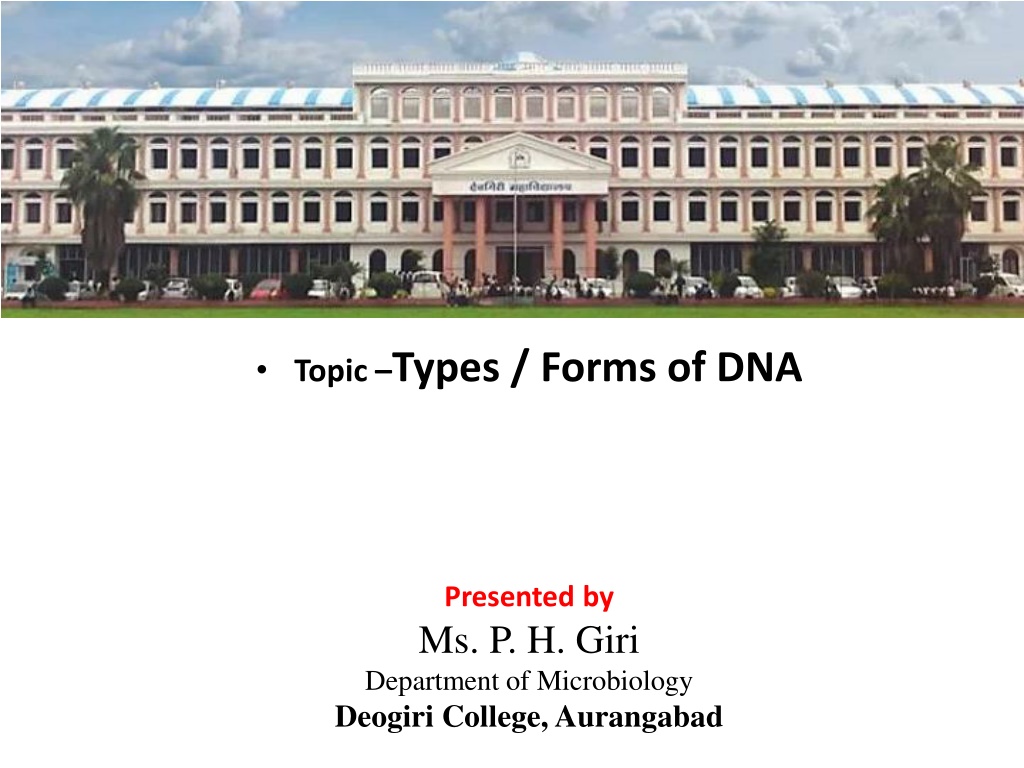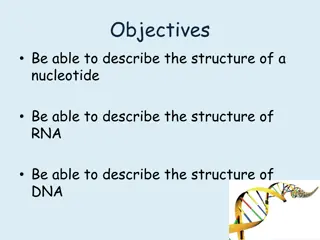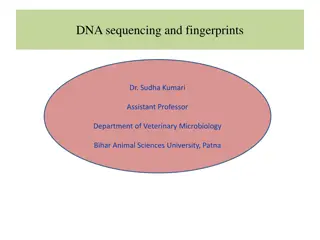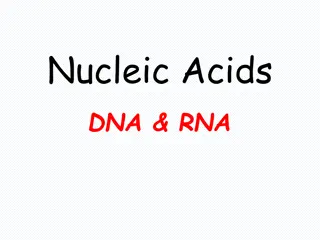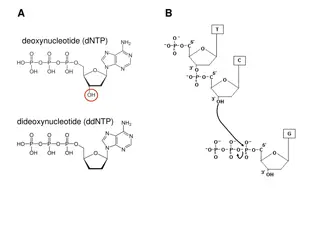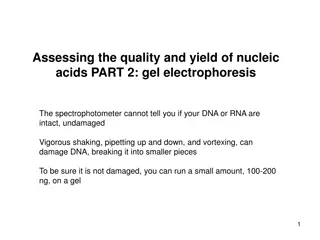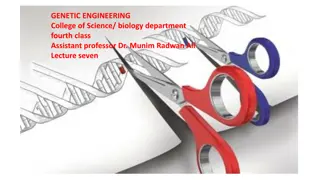Understanding Different Forms of DNA Structures
DNA can exist in various forms such as single-stranded, double-stranded, and mixed forms. The primary, secondary, and tertiary/quaternary structures play crucial roles in determining the overall structure of DNA. Forms like A-DNA and B-DNA have distinct characteristics and are commonly found in different biological systems. Exploring these different forms provides insights into the complex nature of DNA molecules.
Download Presentation

Please find below an Image/Link to download the presentation.
The content on the website is provided AS IS for your information and personal use only. It may not be sold, licensed, or shared on other websites without obtaining consent from the author. Download presentation by click this link. If you encounter any issues during the download, it is possible that the publisher has removed the file from their server.
E N D
Presentation Transcript
Topic Types / Forms of DNA Presented by Ms. P. H. Giri Department of Microbiology Deogiri College, Aurangabad
B.Sc. F. Y. Semester II Paper No. V Basic Biochemistry Unit 4 Nucleic acids Ms. Priyanka H. Giri
Types / Forms of DNA DNA can exist as single, double-stranded, or mixed forms. dsDNA has a linear sequence (primary structure), secondary structure (right handed double helix), and tertiary/quaternary structure (it is folded and packed in the cell).The primary structure is the sequence of nucleoside monophosphates (usually written as the sequence of bases they contain).The secondary structure refers to the shape a nucleic acid assumes as a result of the primary structure. A-DNA, B-DNA and Z-DNA are forms of secondary structure. Tertiary structure refers to large-scale folding in a linear polymer that is at a higher order than secondary structure. The tertiary structure is the specific three dimensional shape into which an entire chain is folded.
A DNA: - The right-handed A form occurs in crystalline structures where the water concentration is reduced. The structure is distorted and the bases are no longer co- planar. A-DNA occurs when DNA is dehydrated, but also in DNA/RNA hybrids. It is a right-handed double helix fairly similar to the more common and well-known B-DNA form, but with a shorter more compact helical structure whose base pairs are not perpendicular to the helix-axis as in B-DNA.
The same helical conformation is the most commonly seen one in double stranded RNA's. There is a slight increase in the number of base pairs (bp) per rotation (resulting in a tighter rotation angle), and smaller rise per turn. This results in a deepening of the major groove and a shallowing of the minor. A thicker right-handed duplex with a shorter distance between the base pairs has been described for RNA-DNA duplexes and RNA-RNA duplexes.
B DNA: - The right-handed B form is the standard form in biological systems. The double stranded DNA molecule is a right-handed helix as determined by Watson and Crick using Franklin's x-ray diffraction images. This B-form of DNA has approximately 10 nucleotides per turn of the helix and is the most common form of DNA found in nature. The most common form, present in most DNA at neutral pH and physiological salt concentrations, is B-form. That is the classic, right-handed double helical structure. The major difference between A-form and B-form nucleic acid is in the conformation of the deoxyribose sugar ring.
It is in the C2' endoconformation for B-form, whereas it is in the C3' endoconformation in A-form. In the C2' endoconformation, the C2' atom is above the plane, whereas the C3' atom is above the plane in the C3' endoconformation. The latter conformation brings the 5' and 3' hydroxyls (both esterified to the phosphates linking to the next nucleotides) closer together than is seen in the C2' endo confromation. Thus the distance between adjacent nucleotides is reduced by about 1 Angstrom in A-form relative to B-form nucleic acid. In B-form, the base-pairs are almost centered over the helical axis, but in A-form, they are displaced away from the central axis and closer to the major groove. The result is a ribbon-like helix with a more open cylindrical core in A-form.
Z DNA: - The left-handed Zform occurs occasionally in the middle of a B-form molecule. A small amount of the DNA in a cell exists in the Z form. Z-DNA is a radically different duplex structure, with the two strands coiling in left-handed helices and a pronounced zig-zag (hence the name) pattern in the phosphodiester backbone. Bases are co-planar in both the B and Z forms. The high salt and GC base-pairs, used to form the DNA crystals cause the helix to twist in a left- handed way, creating a structure called Z-DNA. A third form of duplex DNA has a strikingly different, left- handed helical structure. This Z-DNA is formed by stretches of alternating purines and pyrimidines, e.g. GCGCGC, especially in negatively supercoiled DNA.
The big difference is at the G nucleotide. It has the sugar in the C3' endoconformation (like A- form nucleic acid, and in contrast to B-form DNA) and the guanine base is in the synconformation. This places the guanine back over the sugar ring, in contrast to the usual anticonformation seen in A- and B-form nucleic acid. Note that having the base in the anticonformation places it in the position where it can readily form H-bonds with the complementary base on the opposite strand. The duplex in Z-DNA has to accommodate the distortion of this G nucleotide in the synconformation. The cytosine in the adjacent nucleotide of Z-DNA is in the "normal" C2' endo, anticonformation.
Sugar puckering: Pentose sugar is non-planar. This non- planarity is termed puckering. Pentose ring can be puckered into two basic conformations: 1. Envelope 2. Twisted
Envelope form: In the envelope form, the four atoms of the pentose sugar are nearly coplanar and the fifth is away from the plane. Sugar pucker can be endo or exo. Eg. C2 endo pucker means that C2 is on the same side as the nitrogen base and C4 -C5 bond. And opposite of it for exo pucker.
Twisted form: In twisted form, three atoms are coplanar and the other two lie away on opposite side to this plane. Twisting the C2 and C3 carbons relative to the other atoms results in twist forms of the sugar ring.
Syn and Anti coformations: The bond between the base and sugar is called the glycosidic bond. The base is free to rotate around the glycosidic bond. Due to rotation of glycosidic bond two different conformations are possible: syn and anti.
Functions of DNA: 1. Genetic Information (Genetic Blue Print): DNA is the genetic material which carries all the hereditary information. The genetic information is coded in the arrangement of its nitrogen bases. 2. Replication: DNA has unique property of replication or production of carbon copies (Autocatalytic function). This is essential for transfer of genetic information from one cell to its daughters and from one generation to the next. 3. Chromosomes: DNA occurs inside chromosomes. This is essential for equitable distribution of DNA during cell division.
4. Recombinations: During meiosis, crossing over gives rise to new combination of genes called recombinations. 5. Mutations: Changes in sequence of nitrogen bases due to addition, deletion or wrong replication give rise to mutations. Mutations are the fountain head of all variations and evolution. 6. Transcription: DNA gives rise to RNAs through the process of transcription. It is heterocatalytic activity of DNA.
7. Cellular Metabolism: It controls the metabolic reactions of the cells through the help of specific RNAs, synthesis of specific proteins, enzymes and hormones. 8. Differentiation: Due to differential functioning of some specific regions of DNA or genes, different parts of the organisms get differentiated in shape, size and functions. 9. Development: DNA controls development of an organism through working of an internal genetic clock with or without the help of extrinsic information.
10. DNA Finger Printing: Hypervariable microsatellite DNA sequences of each individual are distinct. They are used in identification of individuals and deciphering their relationships. The mechanism is called DNA finger printing. 11. Gene Therapy: Defective heredity can be rectified by incorporating correct genes in place of defective ones. 12. Antisense Therapy: Excess availability of anti-mRNA or antisense RNAs will not allow the pathogenic genes to express themselves. By this technique failure of angioplasty has been checked. A modification of this technique is RNA interference (RNAi).
RNA (Ribose Nucleic Acid) Ribonucleic acid (RNA) is a biopolymer macromolecule as DNA. It consists of small subunits called nucleotides composed of: Purine nucleobases [Adenine (A), Guanine (G)] Pyrimidine nucleobases [Cytosine (C), Uracil (U)] Ribose pentose sugars [C5H10O5] Phosphate groups [PO43-] The nitrogenous base is attached on the Ribose by an N glycosidic bond The ribose is bonded to the phosphate group through ester bonds The backbone bonding between RNA nuclotides (i.e. the bonds between the phosphate group and an adjacent ribose sugar) occurs through phosphodiester bonds. A phosphate group is attached to the 3' carbon position of one ribose and on the 5' carbon position of the next
Characteristics RNA does not self replicate in order to multiply; instead it is encoded by DNA genes RNA is synthesized in order for the translation of DNA They contain a continuous sequence of nucleotides encoding a specific polypeptide; They are found in the cytoplasm; and They are either attached to ribosomes or capable of such an attachment in order to be translated. Consistent with the range of molecular masses observed for polypeptides, mRNAs vary in length from a few hundred nucleotides to several thousand nucleotides; mRNAs generally are more labile than rRNAs and tRNAs, although the turnover rate for some mRNAs is quite slow.
Types of RNA messenger RNA (mRNA), ribosomal RNA(rRNA) transfer RNA (tRNA).
1. messenger RNA (mRNA) Messenger RNA serves as the template for protein synthesis. It constitutes 2 5 per cent of the total RNA of the normal cell. It was first detected by Hershey (1956). The name and concept of messenger RNA was first given by F. Jacob and J. Monod (1961). Messenger RNA is a linear molecule transcribed from one strand of DNA. It carries the base sequence complementary to DNA template strand. The base sequence of mRNA is in the form of consecutive triplet codons. Ribosomes translate these triplet codons into amino acid sequence of polypeptide chain. m-RNA is formed from the template strand of the DNA duplex. Messenger RNAs encode the amino acid sequences of proteins. Messenger RNA (mRNA) is the RNA that carries information from DNA to the ribosome, the sites of protein synthesis (translation) in the cell. The coding sequence of the mRNA determines the amino acid sequence in the protein that is produced. The sequence carried on m-RNA is read in the form of codon.
2. ribosomal RNA (rRNA) Most of the RNA of the cell is in the form of ribosomal RNA which constitutes about 85% of the total RNA. Ribosomes consist of many types of rRNA. The 70S ribosome of prokaryotes, in its smaller subunit of 30S has 16S rRNA. The 50S larger subunit consists of 23S and 5S rRNA. Similarly 80S ribosome has 18S rRNA in its smaller subunit of 40S. The 60S larger subunit has 28S, 5.8S and 5S rRNA.
3. transfer RNA (tRNA) It transports amino acids to ribosome and decodes the information of mRNA. Each nucleotide triplet codon on mRNA represents an amino acid. The tRNA plays the role of an adaptor and matches each codon to its particular amino acid in the cytopolasmic pool. The tRNA has two properties: (a) It represents a single amino acid to which it binds covalently. (b) It has two sites. One is a trinucleotide sequence called anticodon, which is complementary to the codon of mRNA. The codon and anticodon form base pairs with each other. The other is amino acid binding site.
There are many different kinds of tRNA molecules in a cell. Each tRNA is named after the amino acid it carries. For example if tRNA carries amino acid tyrosine it is written as tRNATyr. Sometimes there are more than one tRNA for an amino acid, then it is denoted as tRNA1Tryand tRNA2Try. A minimum of 32 tRNAs are required to translate all 61 codons. The tRNA charged with an amino acid is called amino acyl tRNA.
The primary structure of all tRNA molecules is small, linear, single stranded nucleic acid ranging in size from 73 to 93 nucleotides. The tRNA due to its property of having stretches of complementary base pairs forms secondary structure, which is in the form of a cloverleaf. Several regions of the single stranded molecule form double stranded stems or arms and single stranded loops due to folding of various regions of the molecule. These double stranded stems have complementary base pairs. A typical tRNA has bases numbering from 1- 76, using the standard numbering convention where position 1 is the 5 end and 76 is the 3 end.
The various regions of the clover leaf model of tRNA are as follows: It has a seven base pairs stem formed by base pairing between 5 and 3 ends of tRNA. At 3 end a sequence of 5 -CCA-3 is added. This is called CCA arm or amino acid acceptor arm. Amino acid binds to this arm during protein synthesis. 1. Amino acid arm: 2. D-arm: Going from 5 to 3 direction or anticlockwise direction, next arm is D-arm. It has a 3 to 4 base pair stem and a loop called D-loop or DHU-loop. It contains a modified base dihydrouracil. 3. Anticodon arm: Next is the arm which lies opposite to the acceptor arm. It has a five base pair stem and a loop in which there are three adjacent nucleotides called anticodon which are complementary to the codon of mRNA. 4. An extra arm: Next lies an extra arm which consists of 3-21 bases. Depending upon the length, extra arms are of two types, small extra arm with 3-5 bases and other a large arm having 13-21 bases. 5. T-arm or T C arm: It has a modified base pseudouridine . It has a five base pair stem with a loop. There are about 50 different types of modified bases in different tRNAs, but four bases are more common. One is ribothymidine which contains thymine which is not found in RNA. Other modified bases are pseudouridine , dihyrouridine and inosine.
pH (potential of hydeogen / power of hydrogen) pH is a measure of the hydorgen ion concentration of a solution. Solutions with a high concentration of hydrogen ions have a low pH and solutions with low concentrations of H+ions have a high pH. The pH of a solution is a measure of the molar concentration of hydrogen ions in the solution and as such is a measure of the acidity or basicity of the solution. pH is a measure of the concentration of H+[H3O+] ions in a solution. Only the concentration of H+and OH-molecules determine the pH. When the concentration of H+and OH- ions are equal, the solution is said to be neutral. If there are more H+than OH-molecules the solution is acidic, and if there are more OH-than H+molecules, the solution is basic.
pH is a scale of acidity from 0 to 14. It tells how acidic or alkaline a substance is. More acidic solutions have lower pH. More alkaline solutions have higher pH. Substances that aren't acidic or alkaline (that is, neutral solutions) usually have a pH of 7. Acids have a pH that is less than 7. Alkalies have a pH that is greater than 7. pH is a measure of the concentration of protons (H+) in a solution. S.P.L. Sorensen introduced this concept in the year 1909. The p stands for the German potenz, meaning power or concentration, and the H for the hydrogen ion (H+). The letters pH stand for "power of hydrogen / potential of hydrogen" and the numerical value is defined as the negative base 10 logarithm of the molar concentration of hydrogen ions. pH = -log10[H+] [H+] indicates the concentration of H+ions in moles per litre (also known as molarity). Most substances have a pH in the range of 0 to 14, although extremely acidic or alkaline substances may have pH < 0, or pH > 14.
Alkaline substances have, instead of hydrogen ions, a concentration of hydroxide ions (OH-). The pH scale measures how acidic or basic a substance is. The pH scale ranges from 0 to 14. A pH of 7 is neutral. A pH less than 7 is acidic. A pH greater than 7 is basic. The pH scale is logarithmic and as a result, each whole pH value below 7 is ten times more acidic than the next higher value. For example, pH 4 is ten times more acidic than pH 5 and 100 times (10 times 10) more acidic than pH 6. The same holds true for pH values above 7, each of which is ten times more alkaline (another way to say basic) than the next lower whole value. For example, pH 10 is ten times more alkaline than pH 9 and 100 times (10 times 10) more alkaline than pH 8. pH measurements are important in agronomy, medicine, biology, chemistry, agriculture, forestry, food science, environmental science, oceanography, civil engineering, chemical engineering, nutrition, water treatment and water purification, as well as many other applications.
pH Scale Principle: H+ion concentration and pH relate inversely. OH- ion concentration and pH relate directly. The following statements may be made about the pH scale numbers. a. Increasing pH means the H+ions are decreasing. b. Decreasing pH means H+ions are increasing. c. Increasing pH means OH-ions are increasing d. Decreasing pH means OH-ions are decreasing
Buffer: A buffer solution (more precisely, pH buffer or hydrogen ion buffer) is an aqueous solution consisting of a mixture of a weak acid and its conjugate base, or vice versa. Its pH changes very little when a small amount of strong acid or base is added to it. Buffer solutions are used as a means of keeping pH at a nearly constant value in a wide variety of chemical applications. In nature there are many systems that use buffering for pH regulation. For example, the bicarbonate buffering system is used to regulate the pH of blood.
Buffer solutions achieve their resistance to pH change because of the presence of an equilibrium between the acid HA and its conjugate base A . HA H++ A When some strong acid is added to an equilibrium mixture of the weak acid and its conjugate base, the equilibrium is shifted to the left, in accordance with Le Chatelier's principle. Because of this, the hydrogen ion concentration increases by less than the amount expected for the quantity of strong acid added. Similarly, if strong alkali is added to the mixture the hydrogen ion concentration decreases by less than the amount expected for the quantity of alkali added.
There are two types of buffer. 1) Weak acid and the salt of the same weak acid, (for example a solution containing ethanoic acid and sodium ethanoate). This gives a buffer solution with a pH less than 7 2) Weak base and the salt of the same weak base (for example ammonia and ammonium chloride solution). This gives a buffer with a pH greater than 7
The acidic buffer works in the following way. If an acid is added it combines its free hydrogen ions with the ions from the salt of the weak acid, making the molecular form of the weak acid, which cannot affect the pH. If a base is added the OH- ions from the base react with the H+ ions that are present from the weak acid dissociation. Having been removed from the solution this stimulates the weak acid to produce more H+ ions (Le Chatelier's Principle) and the original pH is re-established.
Basic buffers A basic buffer is made from a solution containing a weak base and one of its salts. The most common example is a solution of ammonium chloride (salt of a weak base) and ammonia solution (weak base).
PKvalue The Kavalue is a value used to describe the tendency of compounds or ions to dissociate. The Kavalue is also called the dissociation constant, the ionisation constant, and the acid constant. The pKavalue is related to the Kavalue in a logic way. pKavalues are easier to remember than Kavalues and pKa values are in many cases easier to use than Kavalues for fast approximations of concentrations of compounds and ions in equilibriums. During the ionization of weak acid HA, where the ionization is not complete, the dissociation constant is the ratio of the dissociated and undissociated components. [H+][A ] Ka = ------------- [HA]
Hence pKa is defined as the negative logarithm to the base 10 of the Ka in g ions/ L or as logarithm to the base 10 of the reciprocal of Ka. pKa = - log Ka pH = - log H+
pH pKa Relationship log [A ] pH = pKa + ---------- [HA]
